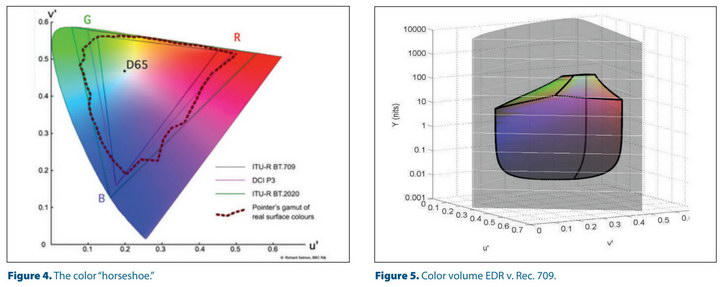The topic of Better Pixels, not more pixels has been a hot topic recently. “Better Pixels” includes several things such as wide color gamut (WCG), high dynamic range (HDR), high frame rate (HFR), etc. This DD is going to focus on the wide color gamut aspect of better pixels.

BT Media and Broadcast has posted a free Research white paper titled “Ultra High Definition Video Formats and Standardisation” and authored by Mike Nilsson. This background on better pixels, including WCG, is essential reading for anyone interested in the issue of better pixels. It covers two major aspects of the problem:
- The technical background for better pixels, including human factors of what improvements people can actually see and what “improvements” would not be readily visible to typical viewers.
- Progress on standards from SMPTE, the EBU and other standards bodies to implement Better Pixels, along with technical work at companies like NHK, Dolby, etc.
One issue with WCG technology is that color is really a three dimensional problem but is commonly shown as a two dimensional problem, as in figure 4 below from The Art of Better Pixels, by David G. Brooks from Dolby and published in the May 2015 issue of the SMPTE Motion Imaging Journal. Figure 4 uses the u’-v’ color space, which is derived from the better known CIE 1931 x-y space.
The third dimension in color is the brightness, as Brooks tries to show in his figure 5. Of course, it is difficult to show the 3D color gamut in a 2D printed publication such as the SMPTE Journal or Display Daily, and that is part of the problem. Improved colorimetry needs not only a larger area on the 2D u’-v’ or x-y plane, but a larger vertical extent along the Y (Luminance) axis. Brooks tries to show this with his perspective drawing whose three axes are u’, v’, and Y. He shows Y as a log scale, running from .001 Nits to 10,000 Nits (candela/M2). To cover this complete range satisfactory, a display would need a contrast of 10,000,000:1. This represents a dynamic range of 7 decades or, in content creator parlance, about 23 stops. For the 0.001 Nits at the low end to be visible, the display would need to be in essentially total darkness. It is doubtful (or at least unknown) if a TV can achieve the 10,000 Nits at the high end and still meet government standards for television power consumption.

All this is very nice and even technically feasible, but when will consumers see better colors on their televisions, tablets and smartphones? There are three steps to better color for consumers:
First Step: The standards from SMPTE, EBU and others need to be in place. Standards writing is a work in progress, documented in the BT Media and Broadcast report and in a document reportedly to be released by SMPTE in the next month or so.
Second Step: Displays with WCG need to be offered to the public. Technology to make these displays is available, at least in the lab. I know of several ways to make a WCG display, including quantum dots, lasers and multiple primary color displays. OLEDs may be an option, too. With dynamic backlights, it may even be possible to get high luminance (for highlights only) and still meet the energy requirements. Since 0.0% reflectivity displays are not really feasible, perhaps the consumer can be trained to watch TV in totally dark rooms.
Third Step: This third requirement, however, is perhaps the most problematical. Content creators need to offer their content color-graded for wide color gamut displays and in a consumer-friendly format. This color-graded content could be encoded by one of the EBU or SMPTE standards for broadcast or carriage on cable. WCG delivery alternatives to EBU or SMPTE broadcast include streaming or delivery on Blu Ray.
One question is which display color gamut will content creators use? The Rec. 709 gamut for HDTV is based on CRT phosphors and really isn’t any bigger than the old SD color gamuts. The Rec. 2020 color gamut for UHD displays isn’t really practical as a display color gamut because it requires lasers to produce the full gamut. Lasers have their own problems, such as cost and speckle.
The Rec. 2020 gamut could be simulated or even improved upon by the use of multiple primary colors. This is technically feasible but not commonly done now and certainly not standardized.
Perhaps the best TV color gamut is one that is rarely if ever mentioned in terms of television – the digital cinema color gamut, also known as the SMPTE P3 gamut. It is feasible with three primary color displays using RGB LEDs or quantum dots as a backlight, plus there is lots of content that the consumer wants to watch on TV and is already color graded for the gamut.
With a P3 WCG display and the other components of better pixels such as HFR and HDR, the image quality at home would be better than in a theater, at least in terms of objectively measured image parameters. Some might consider this a threat to the movie industry but I don’t think so, for two reasons. First, few people can afford a cinema-size image in their home and people like big pictures. Second, people like going out to the movies on a Saturday night, regardless of the image quality. Popcorn anyone? – Matthew Brennesholtz

